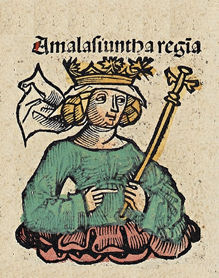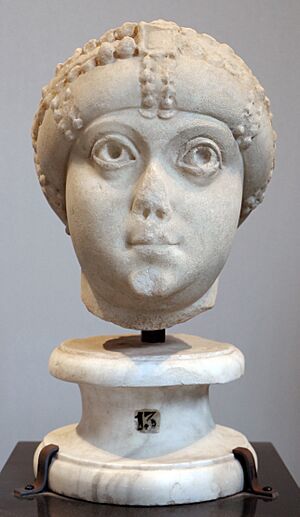Amalasuintha facts for kids
Quick facts for kids Amalasuintha |
|
|---|---|
 |
|
| Queen of the Ostrogoths | |
| Reign | 534 – 535 |
| Predecessor | Athalaric |
| Successor | Theodahad |
| Born | c. 495 |
| Died | 535 (aged 39–40) |
| Spouse | Traguilla Eutharic |
| Issue | Athalaric Matasuntha |
| Dynasty | Amali |
| Father | Theoderic the Great |
| Mother | Audofleda |
| Religion | Arianism |
Amalasuintha (born around 495, died 30 April 534 or 535) was an important leader of the Ostrogoths, a powerful Germanic people. She first ruled as a regent (someone who rules for a young king) for her son from 526 to 534. After her son passed away, she became the queen in her own right from 534 to 535.
Amalasuintha was the youngest daughter of Theodoric the Great, a famous Ostrogothic king. She strongly believed in Roman values and ways of life. She is well-known for her diplomatic talks with Justinian I, the emperor of the Byzantine Empire. When Amalasuintha was killed, Justinian used it as a reason to invade Italy.
Contents
Her Life and Family
In 515, Amalasuintha married Eutharic, an Ostrogoth noble. He belonged to the old Amali dynasty, a very important royal family. Before their marriage, Eutharic lived in the Visigothic Kingdom in Spain.
It was very important to Amalasuintha's father, Theodoric the Great, that she married into a true royal family. This helped make sure that her own family's right to rule was not questioned.
Amalasuintha was a very smart and educated person. She was known for her wide knowledge and love of reading. She could speak Latin, Greek, and Gothic fluently. She also studied philosophy and was said to be very wise. People described her as having many important Roman virtues, like happiness, patience, and being able to have children. However, people focused more on her political skills than her traditional feminine qualities. Like most Ostrogoths, Amalasuintha was an Arian Christian.
Eutharic died early in their marriage, leaving Amalasuintha with two children. Their children were Athalaric and Matasuntha (born around 517, died after 550).
Her Time as Ruler

As Regent for Her Son
When her father, Theodoric the Great, died on August 30, 526, her son Athalaric became king. He was only ten years old. Because he was so young, Amalasuintha took power as his regent. This meant she ruled the kingdom for him.
Her great power as regent can be seen in a special ivory carving called a diptych. This diptych from 530 shows her next to her son, Athalaric. Amalasuintha loved Roman culture very much. She wanted her son to have a good education, with lots of reading and learning, like the Romans. However, many of her Gothic subjects did not like this idea. They preferred the traditional Gothic ways.
Amalasuintha knew that some people did not like her. She sent away, and later had removed, three Gothic nobles. She suspected them of planning against her rule. At the same time, she started talking with the Byzantine emperor Justinian I. She considered moving herself and the Gothic treasures to Constantinople, the capital of the Byzantine Empire. Her son Athalaric died on October 2, 534. This did not seem to change things much at first.
As Queen
After Athalaric's death, Amalasuintha became queen. She ruled alone for a short time. To make her position stronger, she made her cousin Theodahad a co-ruler. Theodahad was a powerful leader among the Gothic military nobles. These were the very people who did not like her pro-Roman ideas. Amalasuintha thought that by making him co-ruler, she could win over her strongest critics.
However, Theodahad encouraged the Goths who were unhappy with Amalasuintha. Either by his orders or with his permission, Amalasuintha was captured. She was imprisoned on Martana Island, which is in Lake Bolsena in Italy. On April 30, 534 or 535, she was murdered there.
Her Death and What Happened Next
Amalasuintha's death gave Justinian I a reason to start a war with the Ostrogoths. He wanted to take control of Italy. Some historians say that Amalasuintha was thinking about giving Italy to Justinian around the time she died.
Soon after Amalasuintha was murdered, Theodahad was replaced by Witigis. Witigis was Amalasuintha's son-in-law. With the support of the people, Witigis had Theodahad removed from power.
Her Legacy
Amalasuintha's life became the topic of a tragedy play. This was the first play written by the young Carlo Goldoni. It was performed in Milan in 1733.
The Romanian poet George Coșbuc wrote a poem called Regina Ostrogotilor (The Queen of the Ostrogoths). In the poem, Amalasuintha (called Amalasunda) talks to Theodahad (called Teodat) just before he kills her.
An Asteroid called 650 Amalasuntha is named in her honor.
Amalasuintha was played by Honor Blackman in the 1968 movie Kampf um Rom.
Images for kids
See also
 In Spanish: Amalasunta para niños
In Spanish: Amalasunta para niños



